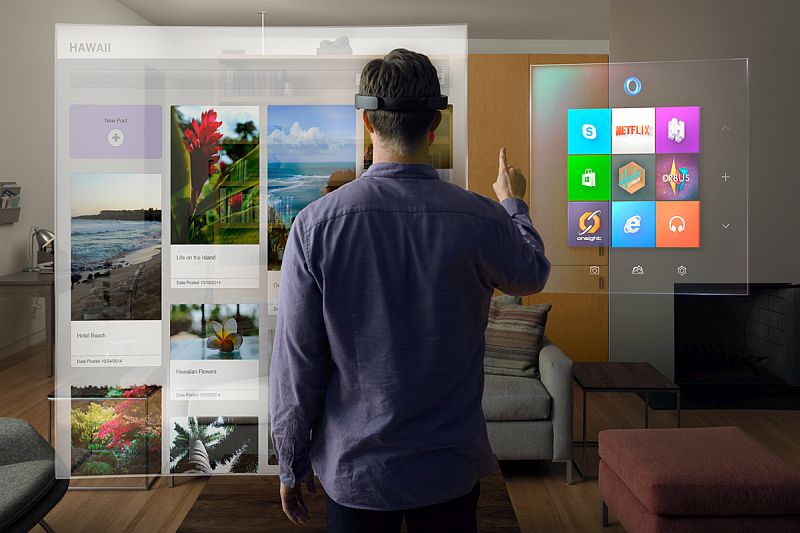- Home
- Wearables
- Wearables News
- Microsoft's FlashBack Could Bring VR to Low End Phones
Microsoft's FlashBack Could Bring VR to Low-End Phones

Virtual reality (VR) segment has seen several consumer-facing products such as the Facebook-owned Oculus, Samsung Gear VR, and HTC Vive, apart from a host of apps for entertainment as well as gaming. The segment has been so far limited to devices with high-quality rendering prowess enabled by a powerful CPU and GPU; though Microsoft's research division wants to change this.
Microsoft Research has introduced FlashBack technology which tries to bring VR across all devices, targeting especially the low-end. The FlashBack is a design point for head-mounted displays (HMD) VR that tries to utilise the storage on a device rather than the CPU and GPU. The Redmond giant claims that it evaluated a prototype implementation of FlashBack technology and noticed up to a 8x improvement in framerate, 97x reduction in energy consumption per frame, and 15x latency reduction compared to a locally-rendered mobile VR setup.
The FlashBack technology during runtime constructs and maintains a hierarchical storage cache index to quickly lookup images that the user should be seeing. The technology, in case misses a cache, uses fast approximations of the correct image while simultaneously fetches more closely-matching entries for future requests.
The research note from Kevin Boos of Rice University, David Chu and Eduardo Cuervo of Microsoft Research explains, "FlashBack memorises costly rendering effort in an offline step to build a cache full of panoramic images. During runtime, FlashBack constructs and maintains a hierarchical storage cache index to quickly lookup images that the user should be seeing. On a cache miss, FlashBack uses fast approximations of the correct image while concurrently fetching more closely-matching entries from its cache for future requests. Moreover, FlashBack not only works for static scenes, but also for dynamic scenes with moving and animated objects."The research note also expresses the need of "affordability" to widespread VR adoption. It adds that the tethered HMDs are expensive while the mobile-rendered HMDs require high-end phones with top-notch GPUs. The availability of VR in affordable devices will mean new use cases. It lists some use cases of affordable VR devices such as virtual field trips for low-income or remote classrooms, enhanced training simulations, medical education and examination among others.
For the latest tech news and reviews, follow Gadgets 360 on X, Facebook, WhatsApp, Threads and Google News. For the latest videos on gadgets and tech, subscribe to our YouTube channel. If you want to know everything about top influencers, follow our in-house Who'sThat360 on Instagram and YouTube.
Related Stories
- Samsung Galaxy Unpacked 2025
- ChatGPT
- Redmi Note 14 Pro+
- iPhone 16
- Apple Vision Pro
- Oneplus 12
- OnePlus Nord CE 3 Lite 5G
- iPhone 13
- Xiaomi 14 Pro
- Oppo Find N3
- Tecno Spark Go (2023)
- Realme V30
- Best Phones Under 25000
- Samsung Galaxy S24 Series
- Cryptocurrency
- iQoo 12
- Samsung Galaxy S24 Ultra
- Giottus
- Samsung Galaxy Z Flip 5
- Apple 'Scary Fast'
- Housefull 5
- GoPro Hero 12 Black Review
- Invincible Season 2
- JioGlass
- HD Ready TV
- Laptop Under 50000
- Smartwatch Under 10000
- Latest Mobile Phones
- Compare Phones
- Moto G15 Power
- Moto G15
- Realme 14x 5G
- Poco M7 Pro 5G
- Poco C75 5G
- Vivo Y300 (China)
- HMD Arc
- Lava Blaze Duo 5G
- Asus Zenbook S 14
- MacBook Pro 16-inch (M4 Max, 2024)
- Honor Pad V9
- Tecno Megapad 11
- Redmi Watch 5
- Huawei Watch Ultimate Design
- Sony 65 Inches Ultra HD (4K) LED Smart TV (KD-65X74L)
- TCL 55 Inches Ultra HD (4K) LED Smart TV (55C61B)
- Sony PlayStation 5 Pro
- Sony PlayStation 5 Slim Digital Edition
- Blue Star 1.5 Ton 3 Star Inverter Split AC (IC318DNUHC)
- Blue Star 1.5 Ton 3 Star Inverter Split AC (IA318VKU)

















